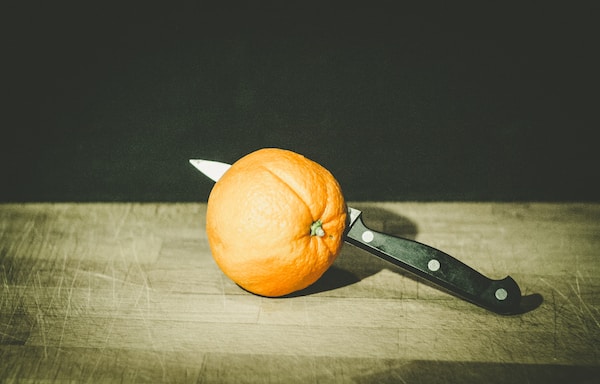
The Ultimate Guide: How to Cut Different Kinds of Fruits
- 6 minutes reading time
Are you an aspiring home cook looking to level up your culinary skills? Are you someone who loves cooking and wants to explore new ways of cutting fruits? If you answered yes to any of these questions, you've come to the right place!
In this comprehensive guide, we'll dive into the art of cutting various types of fruits. From the classic knife techniques to more advanced methods, you'll learn how to handle fruits with finesse and precision.
Knife Skills: The Basics
Before we jump into specific fruit cutting techniques, let's cover some fundamental knife skills. Whether you're a novice or an experienced home cook, knowing the proper way to handle your knife will make a world of difference in your fruit cutting endeavors.
-Grip: Start by gripping the knife handle firmly, but not too tightly. You want to have control over the knife while allowing for fluid movements. -Position: Stand comfortably with your feet shoulder-width apart. Keep your non-dominant hand steady on the cutting board to prevent accidents. -Motion: Master the rocking motion that involves moving the knife back and forth while keeping the tip of the knife in contact with the cutting board. This technique allows for consistent and efficient cutting.
Slicing
One of the most common fruit cutting techniques is slicing. The goal is to create even, uniform pieces with each cut. Here's how to do it:
- Wash and Prep: Start by washing the fruit thoroughly under running water. Remove any dirt or debris. Peel if necessary, and remove any stems or leaves.
- Choose the Right Knife: For most fruits, a sharp chef's knife or utility knife works well for slicing. The blade should be long enough to cut through the fruit with ease.
- Slice in Half: For larger fruits like watermelons or pineapples, start by slicing them in half. This will provide a stable base for further cuts.
- Cut into Sections: Hold one half of the fruit firmly and make vertical slices to create sections. The thickness of the slices depends on personal preference. Make sure to apply even pressure with each cut.
- Create Slices: With sections in place, make horizontal cuts to create slices. Again, the thickness can vary depending on your desired results.
- Serve and Enjoy: Once you've sliced all the fruit, it's ready to be served! Arrange them on a platter or use them as an ingredient in your favorite recipes.
Dicing
If you're looking for smaller, bite-sized pieces of fruit, dicing is the way to go. This technique is perfect for fruits like mangoes, apples, or melons. Follow these steps to dice your fruits like a pro:
- Preparation: Start by washing and peeling the fruit. Remove any unwanted parts such as cores or seeds, if necessary.
- Slice into Planks: Begin by making horizontal slices to create planks. The thickness of the planks will determine the size of your final dice.
- Create Batons: Stack a few planks together and cut them into long, thin batons. Make sure the width matches the desired dice size.
- Make Final Cuts: Gather the batons together and make perpendicular cuts to create small cubes. Aim for even sizes to ensure consistent cooking or presentation.
- Use Your Diced Fruit: Diced fruits are versatile and can be used in various dishes. Add them to salads, desserts, or even as a colorful topping for yogurt or cereal.
Minced
For certain recipes or garnishes, you might need to finely mince your fruits. This technique involves chopping the fruit into tiny pieces to enhance texture and flavor dispersal. Here's how you can achieve a fine mince:
- Prep and Half: Start by washing and peeling the fruit. Cut it in half and remove any pits or seeds, if necessary.
- Slice and Dice: Make thin slices of the fruit, then stack the slices together. Using a rocking motion, chop the slices into small dice-like pieces.
- Finely Mince: Gather the diced pieces together and continue chopping until the fruit is finely minced. Ensure the size and texture are consistent throughout the minced fruit.
- Sprinkle or Blend: Finely minced fruits like ginger or garlic can be sprinkled over dishes for added flavor. You can also blend them into sauces, dressings, or marinades.
Melon Balling
Melon balling is a fun and creative way to serve fruits, especially melons. It involves using a melon baller tool to scoop out perfect spheres. Follow these steps to create beautiful melon balls:
- Choose the Right Melons: Watermelons, cantaloupes, and honeydews are popular choices for melon balling. Select ripe and firm melons for ease of scooping.
- Cut in Half: Start by cutting the melon in half. For larger melons, you can cut them into manageable wedges.
- Scoop it Out: Using a melon baller tool, scoop out the flesh of the melon in a gentle twisting motion. Try to create smooth and round balls.
- Collect and Serve: Place the melon balls in a bowl or on a serving platter. You can garnish them with mint leaves or use them in fruit salads or refreshing summer drinks.
Conclusion
Congratulations! You've now mastered several essential fruit cutting techniques. From slicing to dicing and mincing, you're equipped with the skills to handle different kinds of fruits like a pro.
Remember, practice makes perfect. So, grab your knife, pick a fruit, and start experimenting in your kitchen. Before you know it, you'll be impressing your family and friends with your fruit cutting expertise!
Happy cooking!
All your recipes in one app.
Organize all your recipes now with the best recipe management app. What are you waiting for?

